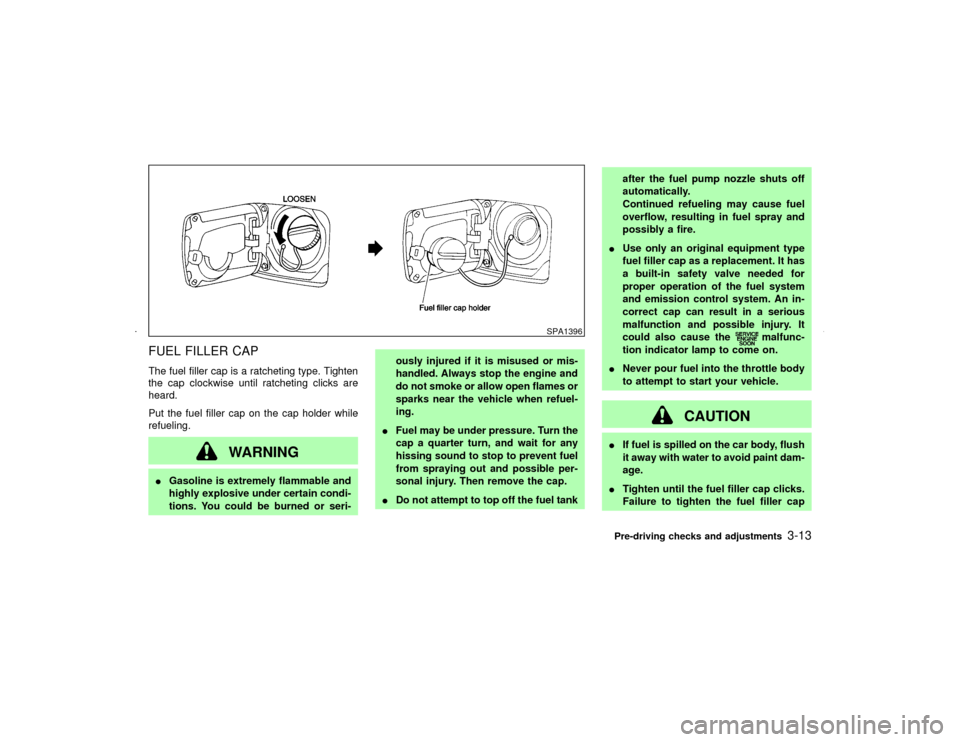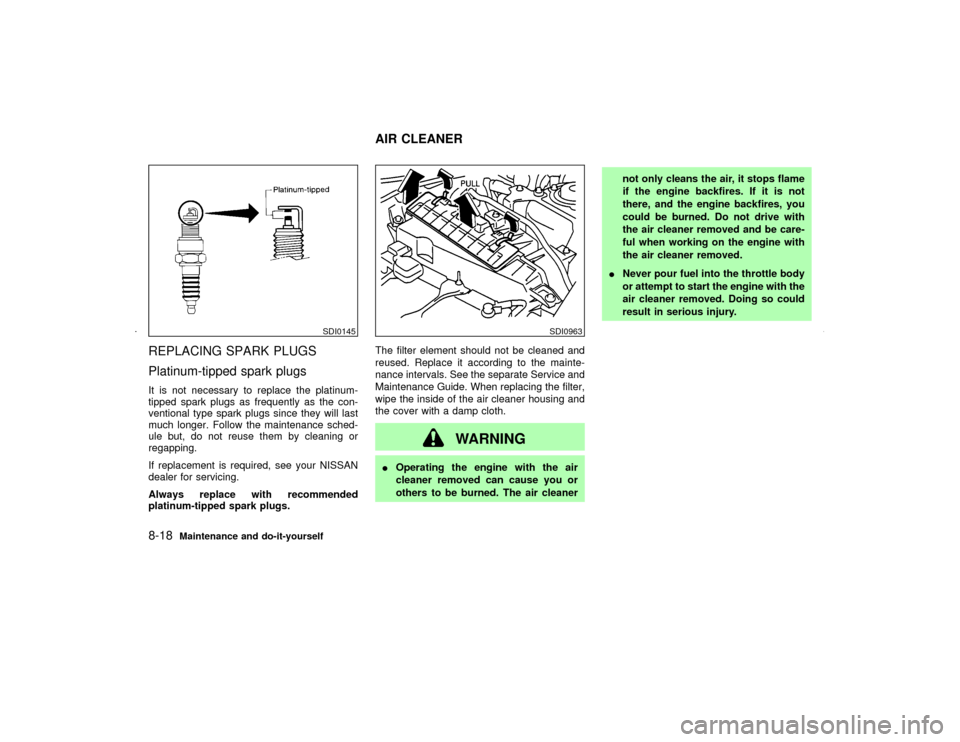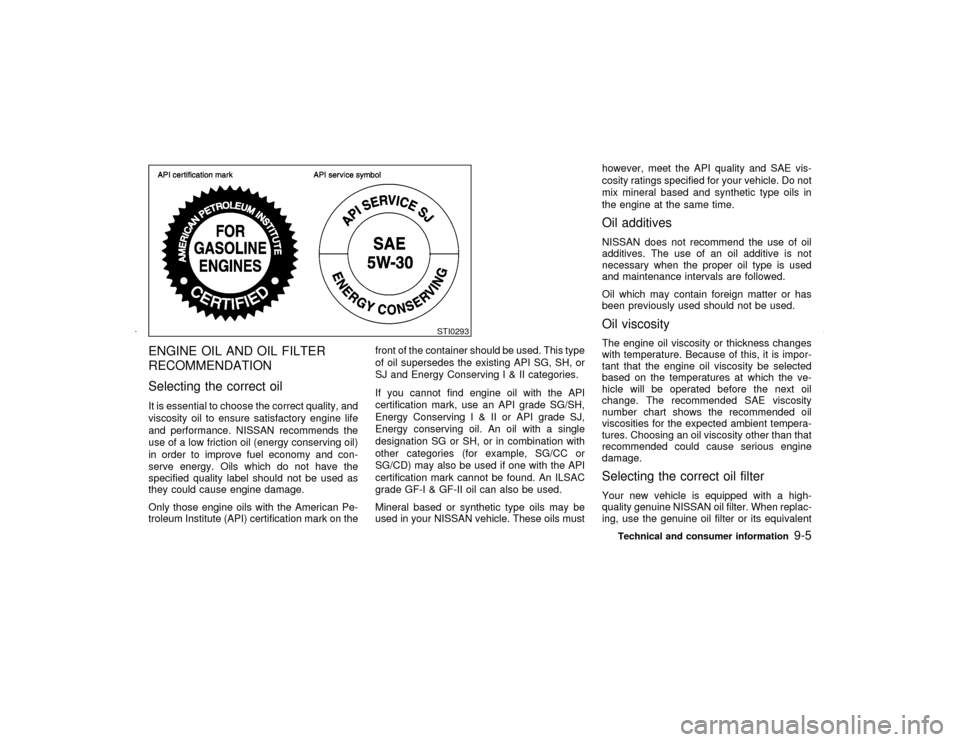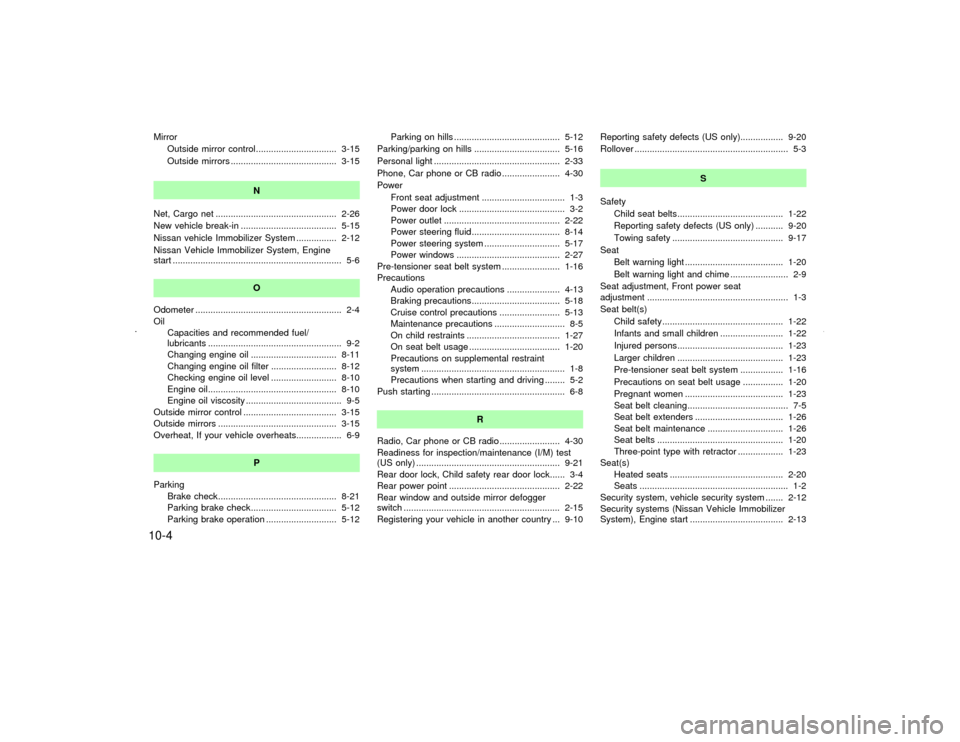2002 NISSAN MAXIMA fuel type
[x] Cancel search: fuel typePage 98 of 247

FUEL FILLER CAPThe fuel filler cap is a ratcheting type. Tighten
the cap clockwise until ratcheting clicks are
heard.
Put the fuel filler cap on the cap holder while
refueling.
WARNING
IGasoline is extremely flammable and
highly explosive under certain condi-
tions. You could be burned or seri-ously injured if it is misused or mis-
handled. Always stop the engine and
do not smoke or allow open flames or
sparks near the vehicle when refuel-
ing.
IFuel may be under pressure. Turn the
cap a quarter turn, and wait for any
hissing sound to stop to prevent fuel
from spraying out and possible per-
sonal injury. Then remove the cap.
IDo not attempt to top off the fuel tankafter the fuel pump nozzle shuts off
automatically.
Continued refueling may cause fuel
overflow, resulting in fuel spray and
possibly a fire.
IUse only an original equipment type
fuel filler cap as a replacement. It has
a built-in safety valve needed for
proper operation of the fuel system
and emission control system. An in-
correct cap can result in a serious
malfunction and possible injury. It
could also cause the
malfunc-
tion indicator lamp to come on.
INever pour fuel into the throttle body
to attempt to start your vehicle.
CAUTION
IIf fuel is spilled on the car body, flush
it away with water to avoid paint dam-
age.
ITighten until the fuel filler cap clicks.
Failure to tighten the fuel filler cap
SPA1396
Pre-driving checks and adjustments
3-13
Z
01.9.21/A33-D/V5.0
X
Page 193 of 247

REPLACING SPARK PLUGS
Platinum-tipped spark plugsIt is not necessary to replace the platinum-
tipped spark plugs as frequently as the con-
ventional type spark plugs since they will last
much longer. Follow the maintenance sched-
ule but, do not reuse them by cleaning or
regapping.
If replacement is required, see your NISSAN
dealer for servicing.
Always replace with recommended
platinum-tipped spark plugs.The filter element should not be cleaned and
reused. Replace it according to the mainte-
nance intervals. See the separate Service and
Maintenance Guide. When replacing the filter,
wipe the inside of the air cleaner housing and
the cover with a damp cloth.
WARNING
IOperating the engine with the air
cleaner removed can cause you or
others to be burned. The air cleanernot only cleans the air, it stops flame
if the engine backfires. If it is not
there, and the engine backfires, you
could be burned. Do not drive with
the air cleaner removed and be care-
ful when working on the engine with
the air cleaner removed.
INever pour fuel into the throttle body
or attempt to start the engine with the
air cleaner removed. Doing so could
result in serious injury.
SDI0145
SDI0963
AIR CLEANER
8-18
Maintenance and do-it-yourself
Z
01.9.21/A33-D/V5.0
X
Page 217 of 247

The following are approximate capacities. The actual refill capacities may be a little different. When refilling, follow the procedure
instructed in the ª8. Maintenance and do-it-yourselfº section to determine the proper refill capacity.
Capacity (Approximate)
Recommended
specifications US
measureImp
measureLiter
Fuel 18-1/2 gal 15-3/8 gal 70 Unleaded gasoline with an octane rating of at least 91 AKI (RON 96)*1
Engine oil*6
Drain and refill
With oil filter change 4-1/4 qt 3-1/2 qt 4.0IAPI Certification Mark*2, *3
IAPI grade SG/SH, Energy ConservingI&IIorAPIgrade SJ, Energy
Conserving*2, *3
IILSAC grade GF-I & GF-II*2, *3 Without oil filter change 3-7/8 qt 3-1/4 qt 3.7
Cooling system
With reservoir 8-1/8 qt 6-3/4 qt 7.7
Genuine NISSAN anti-freeze coolant or equivalent
Reservoir 7/8 qt 3/5 qt 0.8
Manual transmission gear oil Ð Ð Ð API GL-4, Viscosity SAE 75W-90 only
Automatic transmission fluid
Refill to the proper oil level according to the instructions
in the ª8. Maintenance and do-it-yourselfº section.Nissan Matic ªDº (Continental U.S. and Alaska) or Canada NISSAN Auto-
matic Transmission Fluid*4
Power steering fluidGenuine Nissan PSFII or equivalent*8
Brake and clutch fluidGenuine Nissan Brake Fluid*5 or equivalent DOT 3 (US FMVSS No. 116)
Multi-purpose grease Ð Ð Ð NLGI No. 2 (Lithium soap base)
Air conditioning system refrigerant Ð Ð Ð HFC-134a (R-134a)*7
Air conditioning system lubricants Ð Ð ÐNissan A/C System Oil
Type S or exact equivalent
*1: For additional information, see later in this paragraph for fuel recommendation.
*2: For additional information, see later in this paragraph for engine oil and oil filter recommendation.
*3: For additional information, see later in this paragraph for recommended SAE viscosity number.
*4: Dexron
TMIII/Mercon
TM
or equivalent may also be used. Outside the continental United States and Alaska contact a NISSAN dealer for more information regarding
suitable fluids, including recommended brand(s) of Dexron
TMIII/Mercon
TM
automatic transmission fluid.
*5: Available in mainland US through your NISSAN dealer.
*6: For additional information, see ªEngine oilº in the ª8. Maintenance and do-it-yourselfº section for changing engine oil.
*7: For additional information, see ªVehicle identificationº in this section for air conditioner specification label.
*8: Genuine Nissan PSFII, Canada Nissan Automatic Transmission fluid, Dexron
TMIII/Mercon
TM
or equivalent ATF may also be used.
CAPACITIES AND
RECOMMENDED
FUEL/LUBRICANTS9-2
Technical and consumer information
Z
01.9.21/A33-D/V5.0
X
Page 220 of 247

ENGINE OIL AND OIL FILTER
RECOMMENDATION
Selecting the correct oilIt is essential to choose the correct quality, and
viscosity oil to ensure satisfactory engine life
and performance. NISSAN recommends the
use of a low friction oil (energy conserving oil)
in order to improve fuel economy and con-
serve energy. Oils which do not have the
specified quality label should not be used as
they could cause engine damage.
Only those engine oils with the American Pe-
troleum Institute (API) certification mark on thefront of the container should be used. This type
of oil supersedes the existing API SG, SH, or
SJ and Energy ConservingI&IIcategories.
If you cannot find engine oil with the API
certification mark, use an API grade SG/SH,
Energy ConservingI&IIorAPIgrade SJ,
Energy conserving oil. An oil with a single
designation SG or SH, or in combination with
other categories (for example, SG/CC or
SG/CD) may also be used if one with the API
certification mark cannot be found. An ILSAC
grade GF-I & GF-II oil can also be used.
Mineral based or synthetic type oils may be
used in your NISSAN vehicle. These oils musthowever, meet the API quality and SAE vis-
cosity ratings specified for your vehicle. Do not
mix mineral based and synthetic type oils in
the engine at the same time.
Oil additivesNISSAN does not recommend the use of oil
additives. The use of an oil additive is not
necessary when the proper oil type is used
and maintenance intervals are followed.
Oil which may contain foreign matter or has
been previously used should not be used.Oil viscosityThe engine oil viscosity or thickness changes
with temperature. Because of this, it is impor-
tant that the engine oil viscosity be selected
based on the temperatures at which the ve-
hicle will be operated before the next oil
change. The recommended SAE viscosity
number chart shows the recommended oil
viscosities for the expected ambient tempera-
tures. Choosing an oil viscosity other than that
recommended could cause serious engine
damage.Selecting the correct oil filterYour new vehicle is equipped with a high-
quality genuine NISSAN oil filter. When replac-
ing, use the genuine oil filter or its equivalent
STI0293
Technical and consumer information
9-5
Z
01.9.21/A33-D/V5.0
X
Page 243 of 247

Mirror
Outside mirror control................................ 3-15
Outside mirrors .......................................... 3-15
N
Net, Cargo net ................................................ 2-26
New vehicle break-in ...................................... 5-15
Nissan vehicle Immobilizer System ................ 2-12
Nissan Vehicle Immobilizer System, Engine
start ................................................................... 5-6
O
Odometer .......................................................... 2-4
Oil
Capacities and recommended fuel/
lubricants ..................................................... 9-2
Changing engine oil .................................. 8-11
Changing engine oil filter .......................... 8-12
Checking engine oil level .......................... 8-10
Engine oil................................................... 8-10
Engine oil viscosity ...................................... 9-5
Outside mirror control ..................................... 3-15
Outside mirrors ............................................... 3-15
Overheat, If your vehicle overheats.................. 6-9
P
Parking
Brake check............................................... 8-21
Parking brake check.................................. 5-12
Parking brake operation ............................ 5-12Parking on hills .......................................... 5-12
Parking/parking on hills .................................. 5-16
Personal light .................................................. 2-33
Phone, Car phone or CB radio ....................... 4-30
Power
Front seat adjustment ................................. 1-3
Power door lock .......................................... 3-2
Power outlet .............................................. 2-22
Power steering fluid................................... 8-14
Power steering system .............................. 5-17
Power windows ......................................... 2-27
Pre-tensioner seat belt system ....................... 1-16
Precautions
Audio operation precautions ..................... 4-13
Braking precautions................................... 5-18
Cruise control precautions ........................ 5-13
Maintenance precautions ............................ 8-5
On child restraints ..................................... 1-27
On seat belt usage .................................... 1-20
Precautions on supplemental restraint
system ......................................................... 1-8
Precautions when starting and driving ........ 5-2
Push starting ..................................................... 6-8
R
Radio, Car phone or CB radio ........................ 4-30
Readiness for inspection/maintenance (I/M) test
(US only) ......................................................... 9-21
Rear door lock, Child safety rear door lock...... 3-4
Rear power point ............................................ 2-22
Rear window and outside mirror defogger
switch .............................................................. 2-15
Registering your vehicle in another country ... 9-10Reporting safety defects (US only)................. 9-20
Rollover ............................................................. 5-3
S
Safety
Child seat belts.......................................... 1-22
Reporting safety defects (US only) ........... 9-20
Towing safety ............................................ 9-17
Seat
Belt warning light ....................................... 1-20
Belt warning light and chime ....................... 2-9
Seat adjustment, Front power seat
adjustment ........................................................ 1-3
Seat belt(s)
Child safety................................................ 1-22
Infants and small children ......................... 1-22
Injured persons.......................................... 1-23
Larger children .......................................... 1-23
Pre-tensioner seat belt system ................. 1-16
Precautions on seat belt usage ................ 1-20
Pregnant women ....................................... 1-23
Seat belt cleaning........................................ 7-5
Seat belt extenders ................................... 1-26
Seat belt maintenance .............................. 1-26
Seat belts .................................................. 1-20
Three-point type with retractor .................. 1-23
Seat(s)
Heated seats ............................................. 2-20
Seats ........................................................... 1-2
Security system, vehicle security system ....... 2-12
Security systems (Nissan Vehicle Immobilizer
System), Engine start ..................................... 2-13
Z
01.9.21/A33-D/V5.0
X
10-4